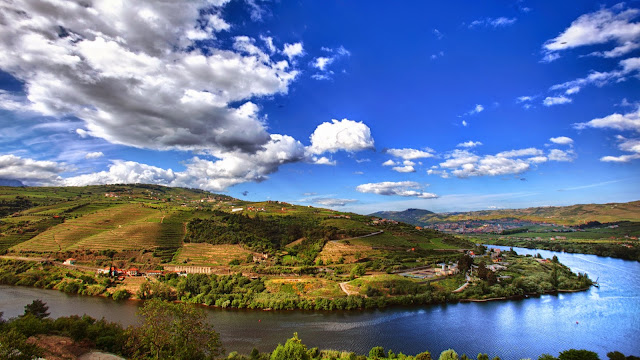Is the Douro Europe's most underrated wine region?
As recently as the late 19th century, the upper reaches of the Douro Valley were a treacherous place to visit. The place was remote. It took days to get there by land from Porto, and the boat trip was hardly any more inviting as it involved negotiating perilous white-water rapids. In 1861, Joseph Forrester, the British wine merchant and mapmaker, was drowned when his boat capsized: the powerful current and gold sovereigns in his moneybelt dragged him under the water. The ladies travelling with him survived, apparently because their fashionable crinolines kept them afloat.
Twelve years after Forrester’s death, work began on a single track railway line that stretched from Porto towards the Spanish border, via around two dozen tunnels and even more bridges, and through what is now a Unesco World Heritage site. The railway was revolutionary, giving access to the vineyards from the city (and vice versa).
The Douro is, of course, port country, though today sweet, fortified wine isn’t its only vinous output: the region also has a growing reputation for excellent red and white wine. Getting there is also much more straightforward, thanks to new roads, and the fact that boats now have a much smoother passage, but my favourite way to travel from Porto is along the magnificent railway line.
The train takes you as far as Pocinho, a tiny village in the Alto Douro, and it still feels as if you are travelling into the back of beyond. The journey is one of the best in the world, and ravishingly beautiful. Set out from São Bento station, whose walls are covered with thousands of blue-and-white glazed ceramic tiles that tell the story of Portugal’s battles and countryside in pictures. The track heads into the heart of the Douro’s wine country, running very close to the river from which steep schist cliffs rise abruptly into the sky. The vineyards criss-cross this landscape like contour lines, sometimes on terraces skirted with hand-built stone walls, sometimes on patamares – terraces cut into the earth by machine. It’s a fantastic way to see the Douro. There are also places to stay at that are close enough to stations to be able to manage without hiring a car.
I usually recommend beginning a trip to the Douro with a night in Porto itself. Portugal’s second-largest city is picturesque, with narrow streets rising from the river. Take a boat trip; marvel at the Dom Luís I bridge, a metal arch over the river designed by Gustave Eiffel; drink white port with tonic; try salted almonds; eat seafood in one of the string of restaurants that overlooks the river. Go for a stroll around Vila Nova de Gaia, which faces Porto on the opposite bank of the Douro. This is where you’ll find the port lodges. Most port shippers store barrels of port for ageing in Vila Nova de Gaia because it’s cooler here than in the Douro Valley where wine can suffer from so-called “Douro bake” unless it’s kept in cool conditions. Once you’ve had your fill of the city, then it’s time to head deep into the Douro. There you can go fishing, boating, walking and tasting. Or simply sit on the veranda of an old quinta – estate – and soak in the scenery.
in: https://www.telegraph.co.uk/travel/destinations/europe/portugal/douro/articles/douro-wine-travel-guide/
The train takes you as far as Pocinho, a tiny village in the Alto Douro, and it still feels as if you are travelling into the back of beyond. The journey is one of the best in the world, and ravishingly beautiful. Set out from São Bento station, whose walls are covered with thousands of blue-and-white glazed ceramic tiles that tell the story of Portugal’s battles and countryside in pictures. The track heads into the heart of the Douro’s wine country, running very close to the river from which steep schist cliffs rise abruptly into the sky. The vineyards criss-cross this landscape like contour lines, sometimes on terraces skirted with hand-built stone walls, sometimes on patamares – terraces cut into the earth by machine. It’s a fantastic way to see the Douro. There are also places to stay at that are close enough to stations to be able to manage without hiring a car.
I usually recommend beginning a trip to the Douro with a night in Porto itself. Portugal’s second-largest city is picturesque, with narrow streets rising from the river. Take a boat trip; marvel at the Dom Luís I bridge, a metal arch over the river designed by Gustave Eiffel; drink white port with tonic; try salted almonds; eat seafood in one of the string of restaurants that overlooks the river. Go for a stroll around Vila Nova de Gaia, which faces Porto on the opposite bank of the Douro. This is where you’ll find the port lodges. Most port shippers store barrels of port for ageing in Vila Nova de Gaia because it’s cooler here than in the Douro Valley where wine can suffer from so-called “Douro bake” unless it’s kept in cool conditions. Once you’ve had your fill of the city, then it’s time to head deep into the Douro. There you can go fishing, boating, walking and tasting. Or simply sit on the veranda of an old quinta – estate – and soak in the scenery.
in: https://www.telegraph.co.uk/travel/destinations/europe/portugal/douro/articles/douro-wine-travel-guide/




